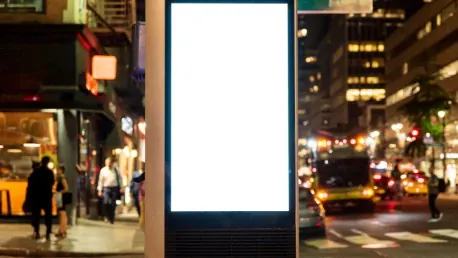Out-of-home (OOH) advertising has shown remarkable resilience in the face of the digital advertising revolution. Despite the rapid growth of digital platforms, which now dominate global ad spending, OOH advertising has maintained its market share and even shows potential for growth. This article explores the factors contributing to the enduring appeal and effectiveness of OOH advertising in a predominantly digital era.
Digital Advertising Dominance
Digital advertising has seen an unprecedented rise, capturing a significant portion of global ad spending. In 2023, digital ads accounted for 71.4% of the $1 trillion global ad expenditure, up from 53% just five years ago. This shift has led to substantial budget reallocations away from traditional media such as TV, radio, and newspapers. The convenience, precision targeting, and measurable outcomes offered by digital platforms have made them the preferred choice for many advertisers. These advantages have undoubtedly contributed to the seismic shift in budget allocations towards digital. However, this dominance has not entirely eclipsed traditional advertising formats.
While TV, radio, and print have seen declines, OOH advertising has managed to hold its ground. This resilience is noteworthy, given the overwhelming trend towards digital. The numbers tell a compelling story of how traditional mediums, especially OOH, remain relevant even as the world becomes increasingly digital. Brands are rediscovering the power of physical presence in a sea of digital noise, capitalizing on the unmissable presence that OOH ads offer.
Steady Investment in OOH Advertising
Despite the digital surge, investment in OOH advertising has been increasing. Billboards, benches, and bus shelters continue to attract significant ad spend. Unlike other traditional formats, OOH advertising has maintained a steady market share, indicating a robust resistance to the digital wave. Industry experts speculate that OOH advertising might even see a rise in its market share, driven by significant investments from major brands like McDonald’s, Apple, and Verizon. This steady investment is a testament to the unique advantages that OOH advertising offers.
Its ability to reach consumers in real-world spaces, where they are less distracted by screens, makes it a valuable complement to digital campaigns. This strategic placement in physical environments ensures that OOH ads capture attention when consumers are in a different frame of mind. These spaces create opportunities for uninterrupted engagement, enhancing the overall effectiveness of the messages conveyed. As digital fatigue sets in, the tangible presence of OOH ads provides a refreshing reminder of the real world, cutting through the virtual clutter to create impactful impressions.
The Unique Appeal of OOH
One of the key reasons for the persistence and potential growth of OOH advertising is its non-digital nature. In an increasingly screen-saturated environment, OOH ads stand out by engaging consumers in physical spaces. This engagement is often less intrusive and more memorable compared to digital ads that interrupt personal activities on screens. This unique appeal lies in the very essence of OOH as an advertising medium that occupies the same physical realm as its audience. The sheer size and strategic placement of OOH ads mean they can’t be ignored.
OOH ads engage people in public settings where they are more alert and socially active. The experience of encountering advertisements in these spaces can be more impactful, as it resonates with the human tendency to be more perceptive and open to external stimuli in communal environments. This natural interaction fosters a connection that digital ads often struggle to achieve. Whether waiting for a bus or walking through a busy city square, individuals are more receptive to the messages conveyed through OOH advertisements, ensuring that the impact lingers long after the initial encounter.
Social and Psychological Impact
The social aspect and psychological impact of encountering ads in public spaces play a crucial role in the effectiveness of OOH advertising. Humans are inherently social beings, and engaging with advertisements in a communal environment can create a more powerful connection than solitary interaction with digital content. The shared experience of seeing an ad in a public space can reinforce its message and make it more memorable. The communal viewing acts as a catalyst, transforming a simple advertisement into a shared cultural touchpoint that resonates with a broad audience.
Additionally, the physicality of OOH ads means they are encountered in environments where audiences are more receptive. This strategic deployment enhances the impact and memorability of the ads, making them a valuable tool for brands looking to create a lasting impression. The physical presence of OOH ads taps into the basic human inclination towards tangibility and presence, creating an emotional bond that purely digital mediums can rarely replicate. Such advertisements invite public engagement and stimulate conversations, leading to a richer and more immersive advertising experience.
Dual Strategy and Digital Integration
OOH advertisements have also started integrating digital elements, benefiting from the dynamic nature of the digital age. More than a third of OOH ad sales are now digital, blending traditional and modern approaches to enhance effectiveness and adaptability. This integration allows for dynamic content that can be updated in real-time, making OOH ads more relevant and engaging. By leveraging digital technology, OOH ads can offer personalized and contextually relevant messages that resonate immediately with target audiences.
Digital tools have enabled more precise metrics to evaluate the success of OOH ads. Brands can track foot traffic and subsequent purchases influenced by these ads, providing tangible metrics for their effectiveness. Programmatic buying has simplified the process, allowing for targeted demographic reach and efficient ad placements. This fusion of digital analytics and traditional advertising formats embodies the best of both worlds, creating a sophisticated and responsive advertising ecosystem. The ability to measure real-time data and adjust campaigns on the fly has revolutionized the potential of OOH advertising.
Iconic and Eyecatching Installations
OOH advertising has seen significant success with iconic and spectacular installations. Examples include The Sphere in Las Vegas and 3D anamorphic signage in Times Square. These high-impact visuals draw substantial attention and are often shared widely on social media, amplifying their reach and effectiveness. The use of such visually immersive technology creates unforgettable experiences that captivate audiences, blurring the lines between art and advertising. These installations stand as monuments to creativity, proving that OOH advertising can rival the most intricate digital campaigns in terms of engagement and recall.
These installations demonstrate the power of creativity in OOH advertising. By creating visually stunning and memorable experiences, brands can capture public attention and generate buzz both offline and online. This approach highlights the potential for OOH ads to complement digital campaigns and create a cohesive marketing strategy. The synergy between eye-catching physical installations and their digital amplification ensures maximum impact. It shows how creativity and innovation in OOH can lead to campaigns that resonate long after consumers have left the physical space.
Targeted Small Scale Campaigns
Out-of-home (OOH) advertising has demonstrated impressive resilience amid the rise of digital advertising. Although digital platforms have surged and now dominate global ad expenditures, OOH advertising has not only sustained its market share but also shows signs of potential growth. This phenomenon is notable given the digital age we live in, where online and social media platforms draw significant attention and ad dollars. Despite this shift towards digital, OOH advertising continues to thrive, drawing in advertisers who recognize its unique benefits. The medium’s ability to capture the attention of consumers in public spaces, create memorable brand experiences, and innovate with technology helps it maintain relevance. From billboards and transit ads to digital installations and interactive displays, the adaptability of OOH advertising keeps it appealing and effective. This article delves into the myriad factors that contribute to the sustained popularity and success of OOH advertising, even in a time when digital seems to dominate every aspect of marketing.









